|
|
|
|
|
| |
Quality general dental care with an emphasis on natural esthetics, form and function. Experience with complex restorative, prosthetic and implant treatment.
----------------------------------------------------------------------------------------
IMMEDIATE DENTAL IMPLANT PLACEMENT
Traditionally, dental implants have been placed following a period of healing of the extraction site or have been placed into the site immediately following extraction of the remaining tooth. Placement of the implant into the site immediately following extraction can be performed when there in not frank infection (active visible exudates also referred to as pus) and primary stability of the implant can be accomplished.
After the dental implant is placed within the bone, a healing period of 2 to 6 month is followed before restoration of the implant. During this period of healing, the implant bonds with the surrounding tissue – a process known as osseointegration. Osseointegration was a term first introduced by Professor Per-Ingvar Brånemark in 1952 when he discovered the ability of living tissue to integrate with titanium. Osseointegration has been described as a direct structural and functional connection between living bone and the surface of a load carrying implant. During his original research, Prof. Brånemark found a way of using titanium as an anchoring unit and support for a variety of prosthetic reconstructions. The long-term predictability and success of Dental implants is based on the fact that an active bond between bone and implant is created at the molecular level. The fixture is not only accepted but also incorporated within the bone.
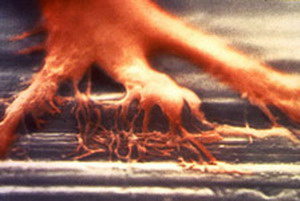
A bone osteocyte cell growing on the surface of a recently placed dental implant.
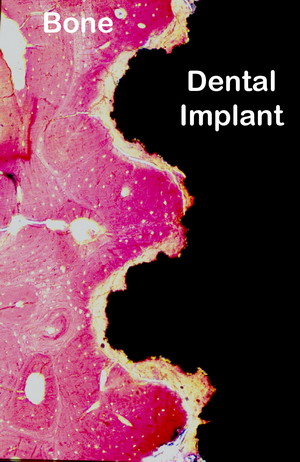
Histology showing close adoption of the patients bone to the dental implant, demonstrating integration of the implant fixture.
But, the question often asked is do we have to wait for the 2-6 month healing period before placing anything on the implants? Frequently when specific criteria are met implants placed in the anterior (front of the mouth) can receive immediate provisional (temporary crowns). This allows the patient to forgo the use of removable temporary dentures or appliances during the healing phase. These criteria include:
- Ability to place the implant into the bone with good primary stability
- An insertion torque of 40 Ncm or greater
- Ability to prevent the provisional crown from being loaded during the healing period
Typically, immediate placement and provisionalization is avoided in the posterior (back of the mouth) as it is more difficult to protect these fixtures from inadvertent loading during eating and functioning. In the case of the posterior these implants may be placed immediately but provisionalization is avoided until adequate healing has occurred.
The patient needs to also understand that during the healing period of several months the implant will slowly integrate with the surrounding bone and the provisional is essentially for esthetics and not function. Chewing should be avoided on the immediately placed and provisionalized implants and all chewing should be in other areas of the mouth.
Let’s review some terminology so that it understood what immediate means. The term immediate is used in two instances with regard to dental implants.
They are:
Immediate placement: This refers to placement of a dental implant into an extraction socket at the time the tooth or root is extracted. When this approach is followed, no healing period occurs between extraction and implant placement and as stated this may be done when no frank infection is present. If has been shown that this approach when possible preserves the bone best as following extraction when the socket is left empty some bone resorption will occur at the crest. Placement of the implant into the immediate site allows stabilization and preservation of this crestal bone.
Immediate loading: This refers to placement of a provisional restoration of the implant at the time the implant is placed. Thus, this is done before any healing has occurred. This may be done in an extraction site or healed site that is receiving an implant. As indicated this can be performed when the implant can be stabilized in the site and loads can be kept off the implant during a period allowing healing.
Determination on immediately placing an implant into an extraction site is usually made at the time of extraction and if the surgeon feels that primary stability is possible then the implant can be placed at the same surgical visit. Should this not be possible, the extraction socket may be filled with an osseous (bone) graft material to allow better healing and fill so that an implant can be placed at a later date. When a delayed placement approach is taken, the site may be left for 6-12 weeks or longer before placement of the implant can be performed. This will be determined based on; how much bone was present around the socket, presence of any infection, condition of the soft (gum) tissue and healing ability of the patient.
If an immediate load is planed, this will be determined at the time of implant placement. It has been well documented in the literature that if the implant can be placed with 40 Ncm of insertion torque that placement of an immediate provisional can be performed. As radiographs only give us some information this factor is determined at time of surgery using instruments to measure the force needed to insert the implant. Should the desired values be achievable at surgery, an impression will be taken at the time of the surgery and a screw retained provisional will be fabricated overnight by the laboratory and inserted the next day.
Immediate provisionalization can be performed for individual implants that will be restored with a single crown or for full arches when all the teeth on the jaw are to be replaced by implants.
What happens if the implant can not be immediately provisionalized? In the case of a single implant or several that are adjacent in the anterior when the patient has the remaining teeth present a removable appliance can be inserted to be worn during the healing. This may be an Essix retainer which is a clear tray that snaps on the remaining teeth with denture teeth in the missing tooth areas. These are comfortable for the patient as they do not cover the roof of the mouth and patients indicate they are more comfortable then a partial denture that would be bulkier and cover the roof of the mouth.
When all the teeth are missing on the arch (jaw) this may require the use of a full denture with a soft liner.
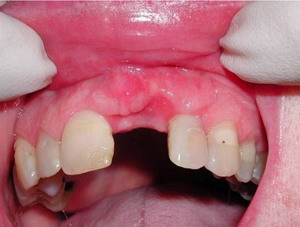
Implant has been placed and awaiting healing
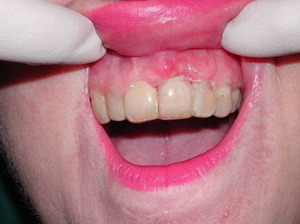
Essix provisional with denture tooth over the healing implant.
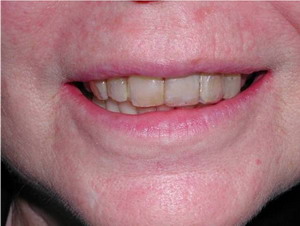
Patient smiling with her Essix provisional showing good esthetics during healing allowing her to function in social situations.
Implant Cosmetic Dental Center™
----------------------------------------------------------------------------------------
Dr. Gregori M. Kurtzman is an international lecturer, selected as one of the top 100 dental speakers since 2006 by Dentistry Today, author of over 200 professional articles, a consultant to multiple dental manufacturers for product evaluation, development and research, he provides general dental care in suburban Maryland since 1986.
|
|
|
|
|
|
|
|
|